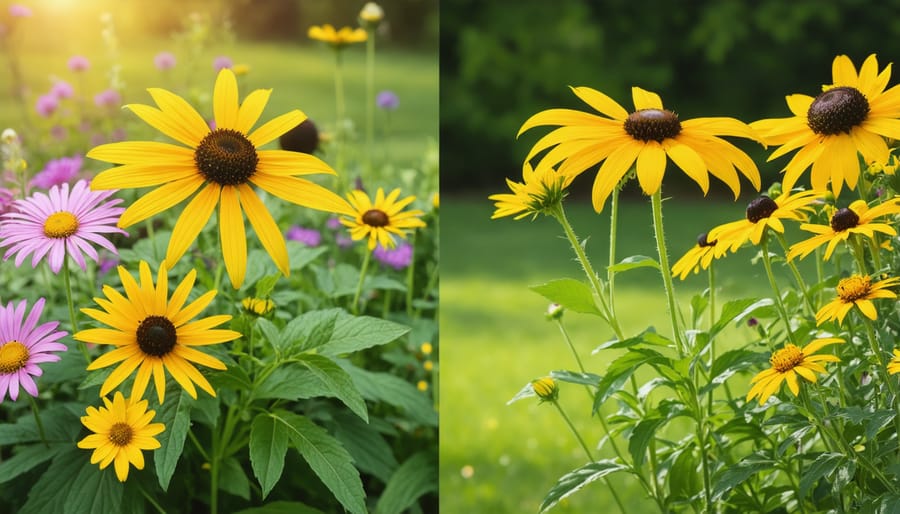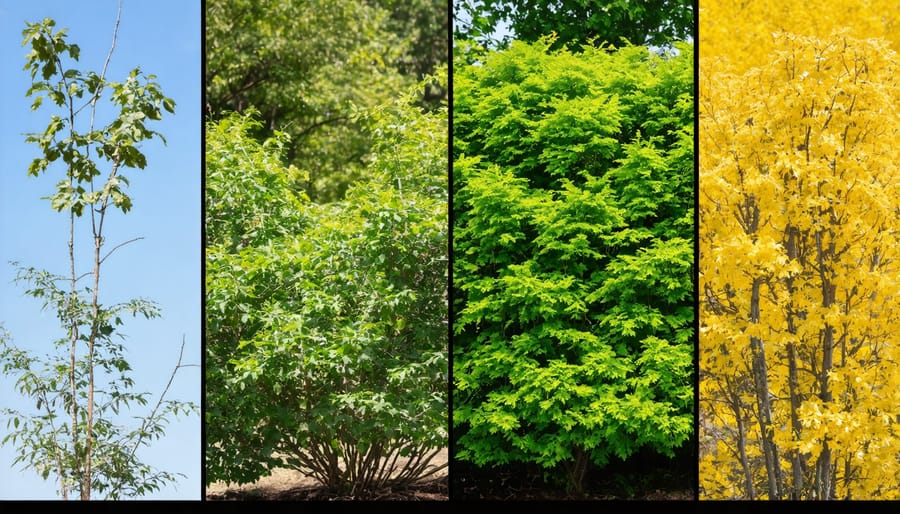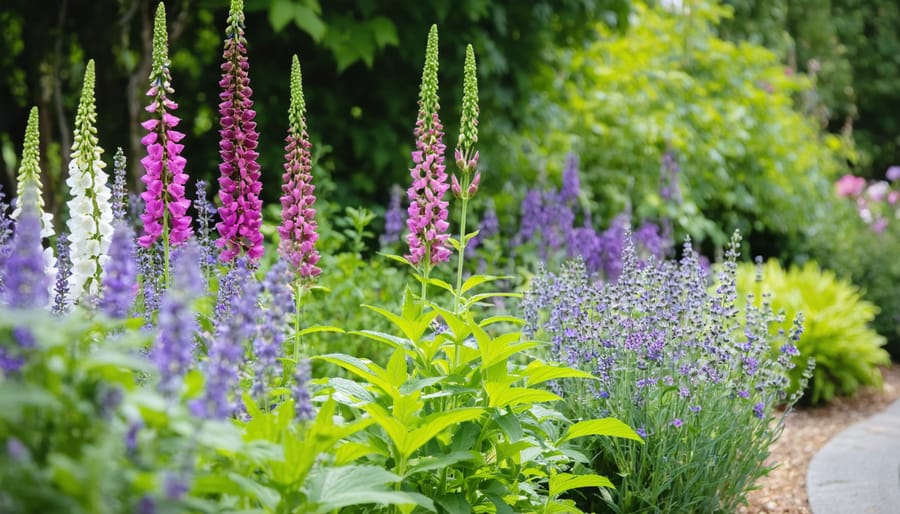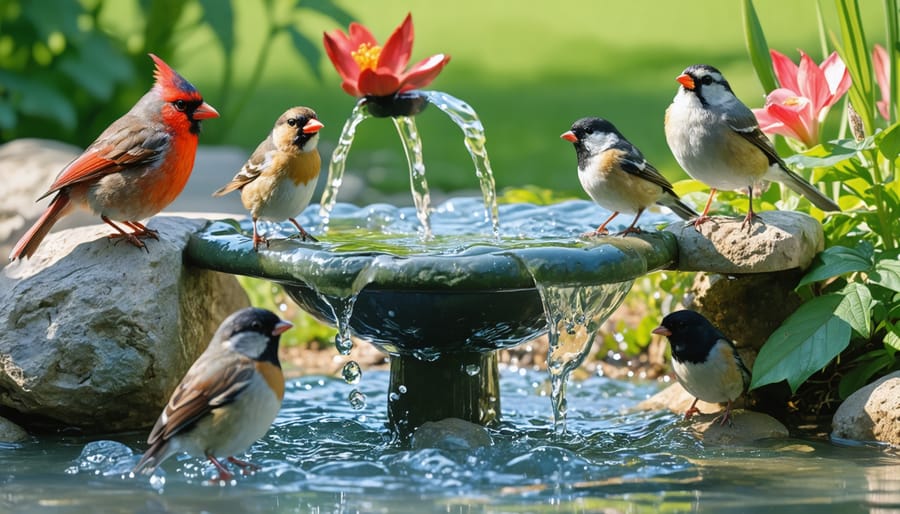Transform your Zone 6 garden into a thriving ecosystem by selecting native plants perfectly adapted to your regional climate. Black-eyed Susans, Purple Coneflowers, and New England Asters naturally flourish in Zone 6’s temperature range of -10°F to 0°F, providing year-round interest and essential habitat for local wildlife. These resilient natives require minimal maintenance once established, making it easy to create a stunning native garden that supports local biodiversity while saving time and resources. Plant Cardinal Flowers and Wild Bergamot in spring or fall when soil temperatures remain consistently above 55°F, ensuring optimal root development before extreme weather sets in. Group plants with similar water requirements together, positioning moisture-loving Joe-Pye Weed and Blue Lobelia in naturally damp areas while placing drought-tolerant Butterfly Weed and Little Bluestem in well-drained spots.
Why Native Plants Thrive in Zone 6
Understanding Zone 6 Climate
Zone 6 spans across much of the central United States, experiencing true four-season weather with moderately cold winters and warm summers. This climate zone typically sees winter temperatures ranging from -10°F to 0°F (-23°C to -18°C) at their lowest, making it a sweet spot for many native plants that need a period of winter dormancy.
The growing season in Zone 6 usually begins in mid-April and extends through October, offering about 150-180 frost-free days. Spring’s last frost typically occurs between April 1-15, while the first autumn frost arrives between October 15-31. These dates can vary by location and yearly weather patterns, so it’s wise to keep an eye on local weather forecasts.
Annual rainfall in Zone 6 averages 30-45 inches, with precipitation fairly well distributed throughout the year. Summer temperatures generally peak in the mid-80s to low 90s Fahrenheit, while spring and fall bring comfortable temperatures ideal for plant establishment and growth. This balanced rainfall pattern and moderate temperature range create excellent conditions for a wide variety of native plants to thrive without requiring extensive supplemental watering once established.

Native Plant Adaptations
Native plants in Zone 6 have developed remarkable adaptations over thousands of years to thrive in the region’s distinct four-season climate. These plants have deep root systems that can reach water during dry spells and protect themselves from winter freezes. Many species go dormant during the coldest months, while others have developed thick bark or waxy leaf coatings to prevent moisture loss. Some native plants time their blooming to coincide with local pollinator activity, ensuring successful reproduction. Their natural resistance to regional pests and diseases means they need fewer interventions to stay healthy. These adaptations make native plants perfect for low-maintenance gardens, as they’re already fine-tuned to handle Zone 6’s temperature swings, from summer highs around 85°F to winter lows near -10°F. Plus, they’ve mastered the art of dealing with the region’s varying rainfall patterns and soil conditions.

Best Native Flowers for Zone 6
Spring Bloomers
As winter releases its grip, Zone 6 gardens burst into life with an array of stunning native spring bloomers. Leading the early-season parade are Virginia Bluebells (Mertensia virginica), whose delicate clusters of sky-blue flowers create a dreamy woodland atmosphere. These charming natives naturally fade by early summer, making them perfect companions for later-emerging perennials.
Wild Columbine (Aquilegia canadensis) puts on a spectacular show with its nodding red and yellow flowers that seem to dance in spring breezes. These adaptable plants thrive in both sun and partial shade, attracting early-season hummingbirds and butterflies to your garden.
Don’t overlook the diminutive but mighty Spring Beauty (Claytonia virginica), whose pink-striped white blossoms carpet the ground in early spring. For shady spots, Bloodroot (Sanguinaria canadensis) offers pristine white flowers that open like stars above unique rounded leaves.
These spring natives not only provide essential early-season nectar for pollinators but also establish a strong foundation for your garden’s seasonal progression. Most spring bloomers prefer rich, well-draining soil and appreciate being planted in fall for best results the following spring.
Summer Stars
As summer temperatures soar, Zone 6 gardens come alive with vibrant native blooms that attract pollinators with native flowers. Leading the show are Purple Coneflowers (Echinacea purpurea), whose sturdy stems hold up majestic purple-pink blooms that butterflies simply can’t resist. These hardy perennials return year after year, creating stunning drifts of color from June through August.
Black-Eyed Susans (Rudbeckia hirta) join the summer parade with their cheerful golden petals and dark centers. These easy-going natives spread naturally, filling sunny spaces with waves of yellow that last well into fall. Plant them alongside Coneflowers for a classic prairie-inspired combination that thrives in Zone 6 conditions.
Don’t overlook Wild Bergamot (Monarda fistulosa), with its lavender pom-pom blooms that bring a touch of whimsy to the garden while attracting bees and hummingbirds. This mint family member adapts well to various soil conditions and creates lovely patches of color in both full sun and partial shade.
These summer stars not only provide weeks of color but also offer vital food sources for local wildlife. Their seed heads persist into winter, adding architectural interest to your garden while feeding native birds. Best of all, these plants require minimal maintenance once established – just occasional watering during dry spells and deadheading to encourage continuous blooming.
Fall Favorites
As autumn approaches, Zone 6 gardens burst into a final display of vibrant colors thanks to late-blooming native flowers. New England Asters steal the show with their rich purple and pink blooms, attracting butterflies and bees well into October. These hardy perennials reach heights of 3-4 feet and create stunning natural borders.
Goldenrod adds brilliant yellow streaks to the fall landscape, and contrary to popular belief, it’s not responsible for seasonal allergies. These sturdy plants provide essential late-season nectar for pollinators preparing for winter. Try Solidago speciosa (Showy Goldenrod) for a well-behaved variety that won’t take over your garden.
Other fall favorites include the deep blue bottles of Great Blue Lobelia and the pristine white flowers of White Snakeroot. For groundcover, Wild Ginger continues providing lush green coverage while Blue Wood Aster spreads delicate purple blooms close to the ground.
These fall-blooming natives not only extend your garden’s beauty through the season but also support local wildlife during a crucial time when food sources become scarce.
Native Trees and Shrubs
Small Trees for Every Garden
Small native trees can transform your Zone 6 garden while supporting local wildlife and maintaining a manageable size. When designing with native plants, these compact trees offer the perfect solution for urban yards and tight spaces.
The Eastern Redbud (Cercis canadensis) stands out as a fantastic choice, reaching just 20-30 feet tall with stunning pink-purple blooms in early spring. Its heart-shaped leaves turn golden in fall, providing year-round interest. For shady spots, consider the American Hornbeam (Carpinus caroliniana), which tolerates partial shade and offers beautiful fall colors.
Serviceberry (Amelanchier canadensis) delivers three-season appeal with spring flowers, summer berries, and fall foliage. Growing to only 15-25 feet, it’s perfect for small yards and attracts birds. The American Plum (Prunus americana) reaches similar heights and rewards gardeners with fragrant spring blossoms and edible fruits.
For the smallest spaces, consider the Pagoda Dogwood (Cornus alternifolia). This understory tree grows 15-20 feet tall, featuring horizontal branching patterns and white spring flowers that give way to blue-black berries beloved by birds.
These native trees not only fit perfectly in compact gardens but also require minimal maintenance once established, making them ideal choices for busy homeowners who want to create beautiful, sustainable landscapes.
Native Shrubs for Structure
Native shrubs form the backbone of a well-designed Zone 6 garden, offering year-round structure and beauty. Red Twig Dogwood stands out as a stunning choice, with its brilliant crimson stems providing dramatic winter interest when other plants have gone dormant. This versatile shrub reaches 6-8 feet tall and thrives in both sun and partial shade.
For reliable foundation plantings, consider Northern Arrowwood Viburnum, which delights with white spring flowers, deep blue berries, and spectacular fall color. It’s particularly valuable for supporting local wildlife, attracting both birds and pollinators throughout the season.
Ninebark deserves special attention for its adaptability and striking appearance. Available in various cultivars, this hardy shrub features exfoliating bark, clusters of white flowers, and leaves that can range from deep purple to chartreuse, depending on the variety.
For smaller spaces, Common Buttonbush makes an excellent choice, reaching just 5-6 feet tall. Its unique spherical flowers resemble white pincushions and are absolute magnets for butterflies and bees. In shadier spots, American Elderberry thrives while providing edible berries for both humans and wildlife.
These native shrubs not only create beautiful garden structure but also require minimal maintenance once established. They’ve evolved to handle Zone 6’s temperature swings and seasonal challenges, making them perfect choices for sustainable landscapes.

Care and Maintenance Tips
Seasonal Care Guide
Caring for your Zone 6 native plant garden requires attention to seasonal changes and timely maintenance. Here’s your month-by-month guide to keeping your garden thriving:
Spring (March-May):
– Remove winter mulch gradually as temperatures warm
– Clean up dead foliage and prune damaged branches
– Divide and replant overcrowded perennials before new growth emerges
– Add a thin layer of compost around plants
– Monitor for early-season pests
Summer (June-August):
– Water deeply during dry spells, focusing on new plantings
– Remove spent blooms to encourage continued flowering
– Control invasive species through regular weeding
– Monitor for pest issues, addressing them naturally when possible
– Add native plants to increase the benefits of plant diversity
Fall (September-November):
– Collect seeds from mature plants for next year
– Leave seed heads and stalks for winter bird food
– Plant new natives until ground freezes
– Apply light layer of leaf mulch around plants
– Cut back dead foliage selectively, leaving some for wildlife
Winter (December-February):
– Add extra mulch around sensitive plants
– Monitor for winter damage after storms
– Keep records of plant performance
– Plan next season’s additions
– Leave snow in place as natural insulation
Remember that native plants are generally low-maintenance, but regular observation and timely care will help your garden flourish throughout the year. Adjust these tasks based on your specific plants and local weather conditions.
Common Challenges
While native plants are generally well-adapted to local conditions, gardeners in Zone 6 may still encounter some common challenges. Fortunately, most of these issues have straightforward solutions.
One frequent challenge is dealing with clay soil, which is common in many Zone 6 regions. To improve drainage and soil structure, incorporate organic matter like compost or leaf mold during planting. Many native plants actually thrive in clay soil once established, but proper soil preparation makes a significant difference in their early growth.
Weather fluctuations can also pose problems, particularly the freeze-thaw cycles typical in Zone 6 winters. Combat this by applying a 2-3 inch layer of mulch in late fall to protect root systems. Just be careful not to pile mulch against plant stems, as this can lead to rot.
Competition from invasive species is another concern. Regular monitoring and prompt removal of invasive plants help protect your native garden. Focus on pulling unwanted plants when the soil is moist, making removal easier and more effective.
Some gardeners worry about native plants looking “messy” or “wild.” Combat this by grouping plants thoughtfully, incorporating defined edges, and maintaining clear pathways. Remember that many native plants can be pruned and shaped just like conventional garden plants while still providing essential ecosystem benefits.
Pest problems are usually minimal with natives, but deer and rabbit damage can occur. Consider installing physical barriers or selecting naturally resistant species if wildlife pressure is high in your area.
As we’ve explored throughout this guide, Zone 6 native plants offer endless possibilities for creating a vibrant, sustainable garden that supports local wildlife while requiring minimal maintenance. By choosing plants that naturally thrive in our region, you’re not just creating a beautiful outdoor space – you’re contributing to the preservation of our local ecosystem and providing essential resources for pollinators and birds.
Remember that starting a native plant garden doesn’t mean you need to transform your entire yard overnight. Begin with a small area, perhaps incorporating a few native perennials or grasses, and gradually expand as you become more comfortable. The joy of watching native plants flourish and attract local wildlife will likely inspire you to add more varieties each season.
Whether you’re drawn to the striking purple coneflowers, the graceful black-eyed Susans, or the sturdy serviceberry shrubs, there’s a perfect native plant combination waiting for your garden. Consider the specific conditions of your space – sun exposure, soil type, and moisture levels – and select plants that match these conditions for the best results.
Take the first step today by visiting your local native plant nursery or connecting with other gardeners in your community. Your Zone 6 native garden will not only bring you years of enjoyment but will also play a vital role in supporting our region’s biodiversity for generations to come.




